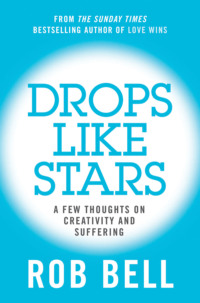
Полная версия
Sex God: Exploring the Endless Questions Between Spirituality and Sexuality

SEX GOD
Exploring the Endless Connections
Between Spirituality and Sexuality
ROB BELL

Contents
Cover
Title Page
Introduction: This Is Really about That
Chapter One: God Wears Lipstick
Chapter Two: Sexy on the Inside
Chapter Three: Angels and Animals
Chapter Four: Leather, Whips, and Fruit
Chapter Five: She Ran into the Girls’ Bathroom
Chapter Six: Worth Dying For
Chapter Seven: Under the Chuppah
Chapter Eight: Johnny and June
Chapter Nine: Whoopee Forever
Epilogue: More Balloons, Please
Acknowledgments
About the Author
Endnotes
Credits
Copyright
About the Publisher
INTRODUCTION This is Really About That
Once there were two brothers.
Jacob had smooth skin. But his older brother, Esau, was “a hairy man.”
And not only was Esau follicly well-endowed, he loved to be outdoors. He was a skillful hunter—picture Ted Nugent in sandals. His smooth-skinned brother? Jacob stayed inside and cooked and hung out with their mother.
You can smell the conflict coming.
Which it does. Their father, Isaac, was dying, and the custom in the ancient Near East at that time was for the father to give his blessing to his firstborn son before he passed away. This was a symbolic gesture loaded with significance. Isaac sends Esau out to kill an animal they can eat as part of the blessing ceremony. But Jacob, at his mother’s prodding, covers himself in goat skins and goes to his ailing blind father, pretending to be Esau. When Isaac hears him, he asks who it is, and Jacob responds, “I am Esau your firstborn.”1
Jacob insists he’s someone else.
Isaac falls for the deception and gives Jacob the blessing he intended to give Esau. Jacob’s lie is a serious offense against the family, against Isaac, and ultimately against Esau. And when Esau finds out, he’s furious and makes it clear that when their father dies, he is going to kill Jacob.
Which Jacob takes as a subtle hint that it’s time to leave town.
So Jacob is on the move, running for his life, when he stops to sleep for the night. The Bible describes the spot where he rests as “a certain place.”2 This detail is significant because this is not a religious site; it isn’t the top of a mountain or the edge of the sea, there isn’t a temple nearby. Jacob falls asleep in a random place by the side of the road. That night, he has a dream. An intense dream in which God speaks to him and says, among other things, “I am with you and will watch over you wherever you go, and I will bring you back to this land. I will not leave you until I have done what I have promised you.”3
What God does here is astounding. People at that time believed the gods resided in religious places, places where gods are expected to be—temples and holy sites and shrines and altars.4 But this God is different.
This God appears at rest areas.
This God speaks to people at “certain places” along the way.
This God doesn’t need temples and holy sites and rituals.
This God will speak to anybody, anywhere, anytime.
Jacob then takes a stone and sets it up as a pillar to mark the spot, making a vow: “If God will be with me and will watch over me on this journey I am taking and will give me food to eat and clothes to wear so that I return safely to my father’s household, then the Lord will be my God.”5
Years pass. Jacob marries, starts a family, and eventually reconciles with Esau. He stops pretending to be someone he’s not. And then one day he returns to the spot where he made his vow to God. The book of Genesis says, “He built an altar, and he called the place El Bethel, because it was there that God revealed himself to him when he was fleeing from his brother.”6
Bet is the Hebrew word for house. El is one of the names for God. Bethel, the “House of God.”
Imagine you’re one of Jacob’s kids: you have just arrived in this new land, and there’s a stone pillar there that your dad can’t stop talking about. He’s telling anyone who will listen this story about something that happened to him years ago, and he’s stacking rocks on top of rocks. He’s stacking them so high, he turns the whole thing into an altar. And he keeps talking about a vow he made to God, and you have no idea what the point of this is. It seems a bit much. And then he starts calling this pile of rocks the House of God.
What if you asked, “Dad, what’s the big deal? They’re just rocks.”7
I imagine Jacob would respond, “Yes, you’re right, they’re rocks, but they’re more than rocks. You have to understand, I was on the run and thought my brother was going to kill me. My life was over. And God saved me. And God brought me to a new home. And I had food to eat and a place to sleep and eventually God gave me a family. These aren’t just rocks. These are a symbol of life for me. God came through for me.”
They’re rocks, but they’re more than rocks.
We do this all the time.
If we were to go through your garage or storage shelves or sock drawer, I guarantee we would find the strangest things. I have a trophy from when I was fourteen. The little man on the top fell off sometime in the ’90s, the lettering that says what it’s for has faded, and the years have revealed that, shockingly, that isn’t real marble. But I’ve kept it. I haven’t thrown it away because it’s more than a trophy to me. That trophy is the first time I actually won something on my own. It represents a certain period of my life and the struggles of being fourteen and finding my identity and wondering if I’d ever be good at anything.
It’s a trophy, but it’s more than a trophy.
Jewelry, pictures, sculptures made by children, antiques that have been in the family for years, art projects, souvenirs, velvet paintings—we hold on to them because they point beyond themselves. If we were to ask you about a certain picture and why you have it displayed in such a prominent place in your home or office or why you carry it in your purse or wallet everywhere you go, you’d probably respond by talking about the people in the picture, where it was taken, when it was taken. But that would only be the start. Those relationships and that place and that time are all about something else, something more. If we kept exploring, you’d probably end up using words like trust and love and belonging and commitment and celebration.
So it’s a picture, but it’s more than a picture.
This physical thing—this picture, trophy, artifact, gift—is actually about that relationship, that truth, that reality, that moment in time.
This is actually about that.
Whether it’s what we do with our energies
or how we feel about our bodies
or wanting to have the control in relationships
or trying to recover from heartbreak
or dealing with our ferocious appetites
or the difficulty of communicating clearly with those we love
or longing for something or someone better,
much of life is in some way connected with our sexuality.
And when we begin to sort through all of the issues surrounding our sexuality, we quickly end up in the spiritual,
because this
is always about that.
And so this guy always has a girlfriend, and it has become a joke among his family and friends that the day he loses one girlfriend, he finds another—they actually use the phrase “trade her in” behind his back—which raises the question, Why does he need to have a girl? What is his real need, the one that drives him to need a girl? And if we could get at that, would he not need a girl so much?
And she’s got a coldness in her heart toward her husband, but it’s really about something that happened years before she even met him.
And he’s got this thing he does, and he keeps telling her that all guys are like this, and she wants to trust him, but she’s dying to know if all guys really are like him, because it’s getting a little weird.
And she’s single and fine with it but still has this sense that she’s a sexual being, and she’s trying to figure out how to reconcile this because her married friends keep trying to set her up with a “nice” guy they know, which gives her the feeling that her friends think she is somehow incomplete because she isn’t married.
And they keep having these arguments about things that are so trivial it’s embarrassing. Yesterday they got into it over how the cars should be parked, and the day before it had something to do with the phone bill, and before that it was about whose turn it was to take the dog out, and now it’s happening again—they’re in the kitchen debating how a tomato should be properly sliced. They’ve been living together now for several years, and they would say it’s been great, but they’re at this point in the relationship where issues like trust and commitment and future and kids and marriage are starting to linger in their minds and hearts, and underneath it all they both have this question: Are you the one? But neither of them has ever actually voiced it, and both of them experienced their parents’ divorcing at a young age, so anytime the subject of marriage comes up, things get confusing and tense very quickly, and so they’re just at this moment realizing that this argument really has nothing to do with how to slice a tomato.
Because this is really about that.
It’s always about something else.
Something deeper. Something behind it all. You can’t talk about sexuality without talking about how we were made. And that will inevitably lead you to who made us. At some point you have to talk about God.
Sex. God. They’re connected. And they can’t be separated. Where the one is, you will always find the other. This is a book about how sexuality is the “this” and spirituality is the “that.” To make sense of the one, we have to explore the other.
And that is what this book is about.
Конец ознакомительного фрагмента.
Текст предоставлен ООО «ЛитРес».
Прочитайте эту книгу целиком, купив полную легальную версию на ЛитРес.
Безопасно оплатить книгу можно банковской картой Visa, MasterCard, Maestro, со счета мобильного телефона, с платежного терминала, в салоне МТС или Связной, через PayPal, WebMoney, Яндекс.Деньги, QIWI Кошелек, бонусными картами или другим удобным Вам способом.






